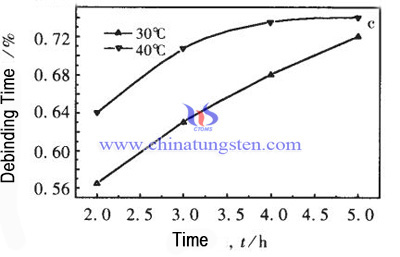Effect of Temperature on Debinding Rate
- Details
- Category: Tungsten Information
- Published on Tuesday, 24 October 2017 23:15
Solvent debinding is widely used in the debinding process of cemented carbide injection molding. Parameters of solvent debinding process have an important impact on the degreasing process and product quality, in which the influence of degreasing temperature is particularly obvious. The temperature not only affects the debinding rate, but also has obvious influence on the bubble, cracking and other defects.
1, Influence Trend
Solvent debinding involves the following basic steps. Diffusion of solvent molecules into tungsten carbide injection molded blank. The binder dissolves in the solvent and forms a binder solvent solution. Binder molecules are diffused into the formed billet surface through the binder solvent solution in the formed blank, and finally are separated from the formed billets into the solvent solution. It can be seen from the figure that the debinding rate increases with the increase of debinding temperature in the same degreasing time.

2, Influence Mechanism
At the beginning, the diffusion process is the control part of the whole degreasing process, and the debinding speed increases with the opening of the pore channel. Temperature is the main factor affecting the rate of diffusion reaction.
The higher the temperature, the molecular motion will be more intensive. Diffusion speed and dissolving speed of low molecular components to the polymer component of organic matter are faster. Chain loose structure is more conducive to the polymer and the polymer is dissolved in the solvent is increased, thus increasing amount of injection molding debinding.
With the increase of temperature, the reaction of diffusion, dissolution and swelling become more intense. Dissolution and volume expansion will lead to swelling cracking, temperature rising and dissolution rate speeding up. The experimental results show that when the debinding temperature exceeds 50 degrees, some samples are bubbling when the binder is injected into the sample. When the temperature exceeds 60 degrees, there will be serious bubbling and cracking in the body.
In the later stage of degreasing, the concentration difference between the solution and the solid body decreases, and the system enters the dissolution control stage, making the concentration difference becomes the main factor that affects the reaction rate. At this time, with low temperature, degreasing binder removal rate is low and the concentration difference between solution and solid body is relatively large, resulting in low temperature degreasing rate is higher than high temperature degreasing rate.
- Tungsten Carbide Manufacturer & Supplier, Chinatungsten Online: tungsten-carbide.com.cn
- Tungsten News & Prices of China Tungsten Industry Association: www.ctia.com.cn
- Molybdenum News & Price: news.molybdenum.com.cn
- Tel.: 86 592 5129696; Fax: 86 592 5129797; Email: sales@chinatungsten.com



 sales@chinatungsten.com
sales@chinatungsten.com